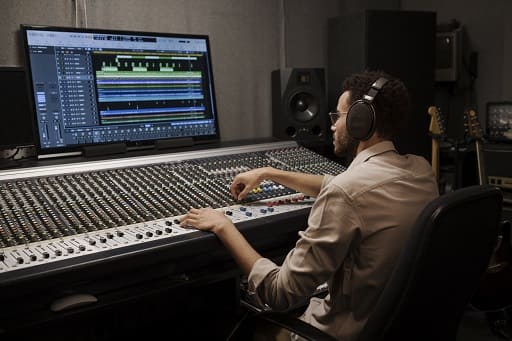Are you looking to add a new dimension of sound design to your films? Working with Melodyne and legendary sound designer Steve Tavaglione in this informative, detailed blog post can turn your film’s audio dream into reality. With decades of experience in creating melodic sequences for major motion pictures, Steve will teach us how he has utilized Melodyne in his own world-renowned productions. Also, if you are not aware of sound design in motion pictures you can read our fundamental guide on sound design in motion pictures.
Discover why Melodyne is an incredibly versatile tool that opens up limitless audio possibilities from crafting complex orchestral arrangements to manipulating synthesizer sounds with confidence.
Steve Tavaglione, Grammy-Winning Sound Designer
Having been nominated for a Grammy award multiple times and being credited with over 200 film and television projects, Steve Tavaglione has made a name for himself in the sound design world. He is recognized as one of the most experienced professionals in the field, having worked with some of the biggest studios including Warner Bros., 20th Century Fox, Disney, Universal, and Paramount. His expertise in sound design has been utilized for major blockbuster films such as The Dark Knight Rises, Jurassic World, and Men In Black 3.
Melodyne & Its Musical Capabilities
If you’re a musician looking for software that can help you take your music to the next level, Melodyne might just be the tool for you. This sound design software allows you to manipulate individual notes and phrases within your recordings, giving you unparalleled control over your music. With Melodyne, you can change the pitch, timing, and even the phrasing of your music, all with a few simple clicks. It’s like having a virtual instrument that can transform your recordings into something truly magical.
How can you use Melodyne to Create Sounds for Film?
Melodyne can be used to create sounds for film in a number of ways.
- First, you can use Melodyne’s pitch-correction capabilities to tune existing recordings, allowing you to achieve great sounding results with minimal effort. This can be especially useful if the source material was recorded out of tune or requires a more specific sound that cannot be achieved simply through traditional recording techniques.
- Second, you can use Melodyne’s audio-morphing capabilities to create unique and interesting soundscapes for film scores. This allows you to blend multiple sounds together, creating a seamless transition between them and creating an atmosphere that would otherwise not be possible with traditional recordings.
- Third, you can use Melodyne’s time-stretching capabilities to create soundscapes that fit perfectly with the timing of a film scene. This allows you to adjust the length and tempo of an audio recording without compromising its quality, which can be especially useful if a specific piece of music needs to match the timing of a scene.
- Finally, you can use Melodyne’s sound-design capabilities to create custom sounds that are impossible to achieve through traditional means. This can be used in a variety of ways, from creating sound effects and ambiance to layering multiple recordings together for a truly unique sound.
Working with Different Instrument Types
Having an understanding of different instrument types is key when using Melodyne for the film. This will allow you to create more realistic-sounding sequences and ensure that your audio blends seamlessly with the other elements in the scene.
For starters, it’s important to understand how each type of instrument responds differently when manipulating its sound via Melodyne. For example, strings are more sensitive to pitch and timing adjustments than woodwinds, while brass instruments respond better to volume changes.
It’s also important to understand how different instrument types interact with one another when layering multiple tracks together. This can be especially helpful if you’re trying to create a unique atmosphere or soundscape for a scene in your film.
Editing Audio Tracks With Ease and Efficiency
Melodyne is renowned for its ease and efficiency when editing audio tracks. This means that you can quickly make adjustments to your recordings without having to spend hours tweaking each sound.
The software also includes a wide range of editing tools that allow you to make precise changes to your recordings, as well as a powerful undo/redo feature that allows you to quickly undo any mistakes. This makes it much easier to experiment with different sounds and quickly find the best one for your scene.
Integrating Melodyne Into Your Workflow
Adding Melodyne to your workflow can be a great way to quickly and easily enhance your recordings. With its powerful editing tools, you’ll have all the control you need over your audio without having to spend hours manually tweaking each sound.
Using Melodyne also allows you to create unique sounds that would otherwise be impossible using traditional recording techniques. Whether you’re creating sound effects, and ambiances or layering multiple recordings together, the software can help bring your audio to life.
Working with Melodyne gives creators the opportunity to make music that stands out from the crowd. As Steve Tavaglione showed us, you don’t have to be a professional musician or engineer to make great-sounding tracks using this powerful software. With its suite of features, Melodyne enables you to quickly and easily fine-tune audio tracks with precision and accuracy, whether it’s for film score production or recording an album. Embrace the power of Melodyne in your workflow and let yourself explore all its possibilities. With some practice, you may find yourself creating unique sounds and compositions that reach new heights!
Originally Published At: https://rianhunter.com/sb/how-to-create-immersive-audio-experiences-melodyne-steve-tavaglione/


No comments yet